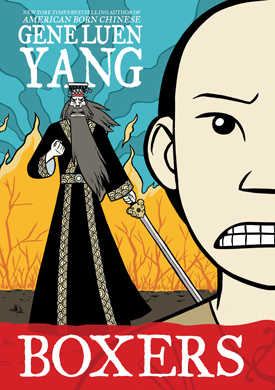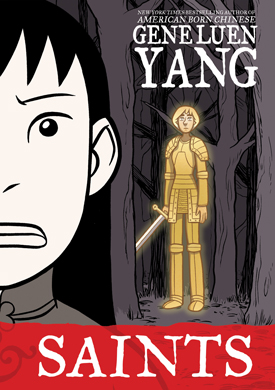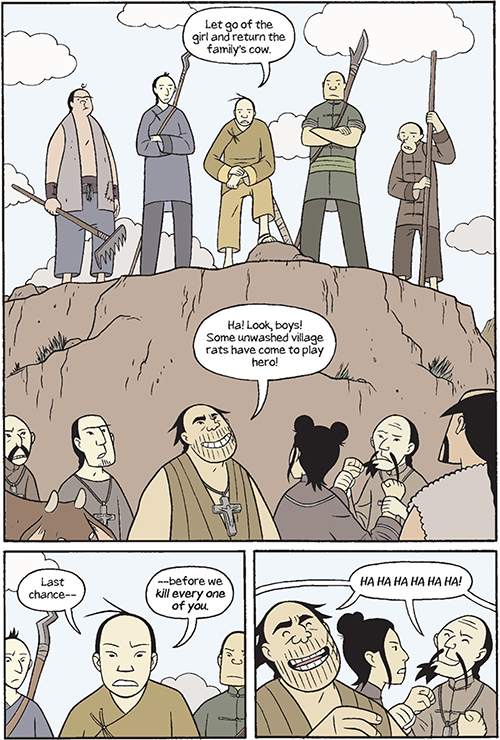Gene Luen Yang a first generation Chinese-American Gained his first taste of acclaim in 2006 with the publication of the graphic novel American Born Chinese (a.k.a. ABC). Published by :01 First Second Publishing, ABC won the Michael L. Printz Award from the American Library Association and an Eisner Award for best new graphic album. It was also the first graphic novel to be a finalist for the National Book Award. Most important to martial artists, it prominently features one of the patron saints of Kung Fu, Sun Wu-Kong, the Monkey King.
There have been other kung fu oriented comic books since the debut of American Born Chinese few have met with equal success. Gene Yang's comic work had seen print in other :01 First Second titles while his sensitivity to martial arts folk culture has earned him a writer credit for comic book adaptation to the much beloved animated series AVATAR: THE LAST AIRBENDER. All the while he's been working on his most ambitious graphic novel yet, BOXERS & SAINTS. Set in China, 1898, this graphic novel features two volumes, each one written from opposite perspectives of the boxer rebellion.
 PL: Have you ever practiced Martial Arts?
PL: Have you ever practiced Martial Arts?
GLY: When I was in Junior High, I did Judo for a few years. I think I got to orange belt before I stopped. I enjoyed it, but I wasn't very good. Even at the age of thirteen, I had an unusually long neck. I was easy to choke. I got really good at tapping out.
PL: BOXERS & SAINTS isn't the first time you've worked on classic Martial Arts heroes where you aware of how popular Sun Wu-Kong (the Monkey King) is among Martial Artists?
Sun Wu-Kong has been a favorite of mine since I was a kid. My mom used to tell me his stories at bedtime. As I got older, I realized just how popular the Monkey King is. I mean, there's a whole continent of Monkey King fans! It makes sense to me that Martial Artists are into him. After all, he's a magic monkey who knows Kung Fu.
PL: Have you ever seen Monkey Kung Fu in action?
GLY: When I was researching BOXERS & SAINTS, I found a bunch of Chinese opera video clips on YouTube. The most exciting ones were of the Monkey King doing his thing. I'm not sure if the actor was performing the Monkey Kung Fu you're referring to, but he was definitely impressive.
PL: Which came first AVATAR: THE LAST AIRBENDER or Boxers & Saints?
GLY: I started Boxers & Saints right after American Born Chinese came out in 2006. I didn't sign on to write the AVATAR: THE LAST AIRBENDER comics for Dark Horse until 2010. Even though the Airbender comics were published first, I've been working on Boxers for much, much longer. There's resonance between the projects because the Airbender universe draws heavily from Asian culture. For instance, the city of Ba Sing Se is a fantastical version of Qing Dynasty China. The Boxer Rebellion occurred at the very end of the Qing Dynasty.
 PL: What inspired you to create BOXERS & SAINTS?
PL: What inspired you to create BOXERS & SAINTS?
GLY: I'm fascinated by the Boxer Rebellion, so I wanted to do a historical fiction comic about it. The Boxer Rebellion is a war that was fought on Chinese soil just over a hundred years ago. Back then, the Chinese government was incredibly weak, so the Western powers went in and established what were called concessions, communities in all the major Chinese cities that basically functioned as colonies.
A group of poor, illiterate Chinese teenagers living in the farmlands felt deeply embarrassed by this foreign incursion. They came up with this mystical ritual where they would call down the traditional Chinese gods from the heavens and the gods would give them superpowers. Then armed with the superpowers, they ran through the countryside, killing European soldiers, missionaries, and Chinese Christians. Because the teenagers' martial arts was reminiscent of European boxing, the Europeans called them Boxers.
PL: You've created a sort of Avengers team in Boxers & Saints including THE MONKEY KING, Qin Shi Huang, Chu Ba-Jei the repentant Pig and Guan Yu to name a few. Can you name some more?
GLY: Well, there's Mu Guiying, a legendary woman general, and Zhang Fei, one of the Brothers of the Peach Garden Oath. The one notable Chinese hero who isn't a part team is Liu Bei, another Brother of the Peach Garden Oath. He's also considered the patron of shoemakers in parts of China. I wanted to use his absence to show what is absent from my protagonist's understanding of Chinese stories.
PL: Why those characters? How do they relate to more western hero/warrior archetypes?
GLY: The history of the Boxer Rebellion dictated that I use those heroes, those gods. Those were the gods who the Boxers called upon, who empowered the Boxers with magic powers. I'm a superhero comics fan, so I see a lot of commonalities between the Chinese gods and Western superheroes. Both wear colorful costumes, both have superhuman abilities, both go on epic adventures, and both are a source of empowerment for young readers.

PL: How about the hermit on the mountain, was that Bai Mei?
GLY: The hermit on the mountain was inspired by a historical figure. In the book Origins of the Boxer Uprising, scholar Joseph Esherick talks about this wandering martial arts master who had a giant belly. Rumor was that his belly was so swollen because there was a mystical eye in the middle of it. Esherick only gave this guy a couple of sentences, but I found him so intriguing that I included him in my book.
PL: How about the research you did for the costumes and weapons? Good job on the traditional weapons like the Kwan Dao plus a rake? and was that a snake spear?
GLY: Because the Boxers encountered the stories of their heroes through Chinese opera, I looked to Chinese opera for the details. The weapons my characters carry in the book aren't based on the actual weapons, but on the Chinese opera versions of the weapons. I guess in many cases there isn't that big of a difference, especially after the weapons have been "cartoonified."
And yes, that's a snake spear.
PL: You also used the jian as a sort of Excalibur as well, was that intentional?
GLY: I think the sword as a source of mystic power is pretty common in literature. I wanted to draw on that tradition. It just… I don't know… felt like it fit.
PL: Would it be a spoiler to mention how bloody the comic ends up being?
GLY: Boxers & Saints is definitely the bloodiest, most violent story I've ever told. And it had to be, because the Boxer Rebellion was so bloody and so violent. If I wanted to be honest about the historical event, I couldn't get around the violence.
PL: A lot of people get killed.
GLY: Yep. By the end of the Boxer Rebellion, thousands of soldiers and tens of thousands of civilians had been killed.

PL:Did you see the THE LAST AIRBENDER movie adaptation?
GLY: Nope. And I never will. In fact, that's how I got the job writing the comics. I did a webcomic that advocated a boycott of the live action movie because of the casting. An editor at Dark Horse read the webcomic, found out I was an AVATAR: THE LAST AIRBENDER fan, and offered me the job.
PL: Let's talk about you working on the AVATAR comics. What's it like working on it?
GLY: Working on the Avatar comics has been a real privilege. I've gotten an up-close look at how Mike and Bryan's story instincts work. And I've gotten to play with these characters that I love.
This year, Dark Horse is putting out AVATAR: THE LAST AIRBENDER - The Search. We're finally going to answer the question that's perplexed Airbender fans since the end of that first series: What happened to Zuko's mom?
PL: We've interviewed Sifu Kisu who adapted a variety of Kung Fu styles to the animated bending styles. Are you trying to incorporate some of that work into the Avatar comics as well?
GLY: The Airbender comics are drawn by Gurihiru, an art studio based in Japan. When it comes to the martial arts in the comics, they handle all the hard stuff. And they're just shockingly good. If you've seen the comics, you'll know what I'm talking about. They're able to capture the humor and drama and action of the original series, all while giving each page a charisma that uniquely Gurihiru.
PL: How about THE LEGEND OF KORRA?
GLY: Yes, I've watched all of the first season. Bryan Konietzko and Mike DiMartino have really done something amazing. The world they've built is just incredible. From the music to the architecture to the character designs, they've blended Eastern and Western cultures to create this living, breathing society. And the fight scenes… man. They're head and shoulders above the ones in the first series.
PL: What's next?
GLY: Next year, First Second Books will be publishing The Shadow Hero, which is written by me and drawn by Sonny Liew. It's a revival of an obscure Golden Age superhero who's fallen into public domain. He's called the Green Turtle, and some people argue that he's the first Asian American superhero. I'm really excited about the book, especially after seeing some of Sonny's finished pages. It's superhero action set in 1930's Chinatown, drawn by one of the emerging superstars of the comics industry.
Are you sending the kids to Martial Arts classes?
The oldest was in Taekwondo, but he gave it up for basketball. We're planning to send our second and third to some sort of martial arts. They need to toughen up. I have a brother-in-law who's really into Brazilian Jujutsu - he owns a gym in Thailand. So we're looking into that.
About
Patrick Lugo :
![]() Patrick Lugo has been Senior Designer at Kung Fu Tai Chi Magazine, since the 90's, has done design work for martial art books as well as illustrations, most notably, illustrating the award winning Little Monk & the Mantis. More artwork and comics can be found at PLUGOarts.com.
Patrick Lugo has been Senior Designer at Kung Fu Tai Chi Magazine, since the 90's, has done design work for martial art books as well as illustrations, most notably, illustrating the award winning Little Monk & the Mantis. More artwork and comics can be found at PLUGOarts.com.
BOXERS & SAINTS artwork © Gene Luen Yang, used with permission of First Second Books.
![]() Print Friendly Version of This Article
Print Friendly Version of This Article
















